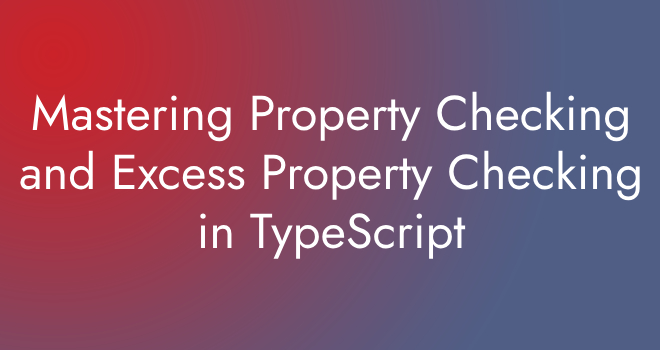TypeScript is a powerful statically typed JavaScript superset that improves code safety and correctness. Properties Testing & Excess Property Checking are two critical TypeScript notions that ensure your code works as expected. This essay will go over these ideas and their actual applications.
Understanding Property Checking
The process to check if an item conforms to a given type or interface is known as property checking. It guarantees that an object has the expected characteristics and types. TypeScript checks properties at compile time, allowing for early error discovery. Let’s look at an example:
interface Person {
name: string;
age: number;
}
function greet(person: Person) {
console.log(`Hello, ${person.name}! You are ${person.age} years old.`);
}
const john = { name: "John", age: 30 }; // Valid
const sarah = { name: "Sarah" }; // Error: 'age' is missing
greet(john); // Valid
greet(sarah); // Error: 'sarah' is missing 'age' propertyThe Person interface in the preceding code describes the structure of a person object. The greet method anticipates an object that adheres to this interface. Property verification verifies that the objects supplied to greet have the same structure as stated.
Investigating Excess Property Checking
Excess Property Checking, on the other hand, prohibits objects from acquiring additional properties that are not defined in the type or interface. To ensure code integrity, TypeScript applies this check. Here’s an illustration:
interface Car {
make: string;
model: string;
}
const myCar = { make: "Toyota", model: "Camry", year: 2023 }; // Error: 'year' is unexpectedThe Car interface defines the expected properties manufacture and model in this situation. The myCar object has one additional property, year, which causes a compilation error. Excess property checking guarantees that objects tightly adhere to the types and structures declared.
Handling Excess Properties
There are times when you want to allow objects with additional characteristics. TypeScript has two techniques for doing so:
Type Assertion:
const myCar = { make: "Toyota", model: "Camry", year: 2023 } as Car;Type assertion (as Car) instructs TypeScript to skip the excess property check, treating the object as though it conforms to the provided type or interface.
Type Casting:
const myCar = { make: "Toyota", model: "Camry", year: 2023 };Type casting achieves the same result by explicitly instructing TypeScript to treat the object as of the specified type.
Property checking and excess property checking are key TypeScript notions that increase code safety and maintainability. Property checking guarantees that objects conform to prescribed types, whereas excess property checking avoids unwanted extra characteristics. Understanding and effectively applying these notions will assist you in writing robust and error-free TypeScript code.
Embrace these checks as you progress through your TypeScript journey to realize the full potential of static typing, discovering possible issues early in the development process, and constructing more reliable apps.


Nice Topic Sir.
🌕🌕🌕🌕🌖
My Rating For This Topic is 4.7 out of 5.